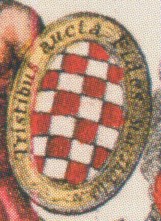Croatian Coat of Arms
during centuries
Darko Zubrinic, Zagreb, 2005
- until 1600
- 1600-1800
- 1800-1900
- 1900 until today
- References

Croatian
coat of arms rom the book by Mavro Orbini:
Il regno de gli Slavi,
Pesaro 1601

Epitaph
of Croatian ban Toma Erdödi (1558-1624) in the Zagreb Cathedral,
with Croatian coat of arms (Regnum
Sclavoniae, Croatiae, Dalmatiae):

Erdödi
is important for organizing and participating in
the 1593
battle near Sisak against the
Turks. The victory echoed in the whole of Europe.

Croatian Coats of Arms of Croatia, Dalmatia and Slavonia on a talir of King Matthias II, 1614.
Photo from Bože Mimica: Dalmacija u moru svjetlosti, 1. Dio, Rijeka, 2004.
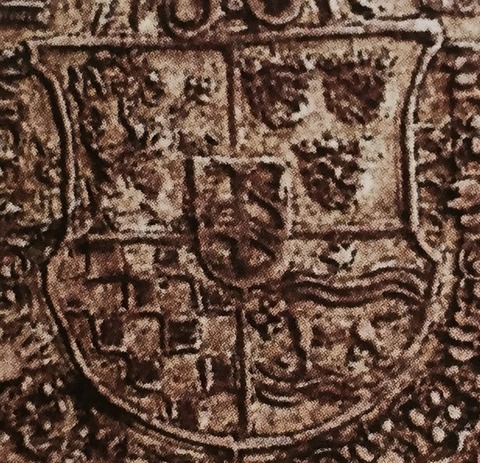

Mausoleum of Holy Roman Emperor, King of Bohemia, Hungary and Croatia (etc), Ferdinand II of Habsburg,
built in 1637 in the year of his death. In the middle of the photo are Coats of Arms, including Croatian.

Enlarged detail from the photo preceding it. The three Coats of Arms near the bottom represent
Dalmatia (3 leopards' heads), Rama (in Bosnia), and Croatia. Many thanks to Tomislav Beronić for these two photos.

Chest
of privileges of the Kingdom of Dalmatia, Croatia and Slavonia, with
Croatian legal documents, 1643
kept in the Croatian State Archives
The oldest surviving Croatian flag, dating from 1647, used during the coronation of Ferdinand I in Szekesfehervar.
It is the coronation flag with the Coat of Arms of Croatia, made of embroidered silk, 161 x 266 cm.
Kept in Burg Forchtenstein in Northern Burgneland (Gradišće) in Austria (Croatian name of the Burg is Fortnavski grad).
Exibited at the Klovićevi dvori Museum in Zagreb, in the Automn 2020.
Coats of Arms of Dalmatia and Croatia (above) and of Slavonia (below) from 1650 (details),
oil on canvas kept in Hungarian National Museum, Budapest.
Exhibited in the Automn 2020 in Klovićevi dvori in Zagreb.
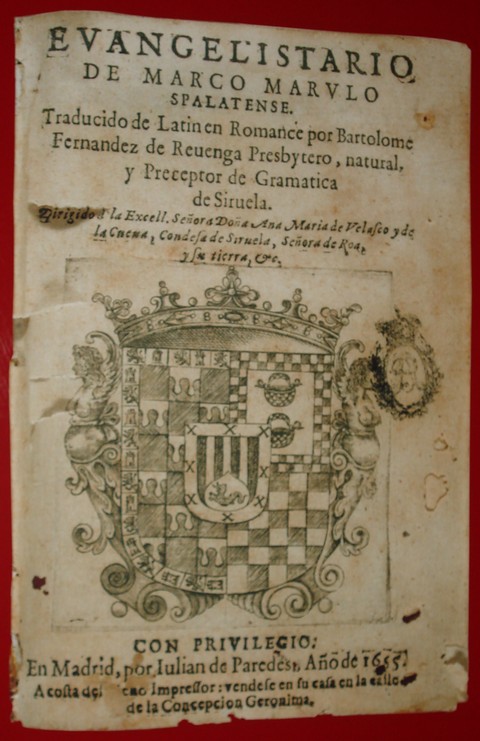
Marko Marulic's
Evangelistarium published in Spanish in Madrid in 1655. Note Croatian
Coat of Arms in the middle. Photo exhibited by The
Split Literary Circle.
Copper plate engraving from 1655, representing Leopold I.
On the left, Coats of Arms of Dalmatia (three leopards), Croatia, Bosnia (hand with a sward) and Slavonia.
Exhibited at the Klovićevi dvori Museum in Zagreb, Automn 2020.
Coronation of Leopold I in Požun, 1655. Kept in Hungarian National Museum in Budapest.
On the left, there are Coats of Arms of Slavonia, Croatia, Bosnia and Dalmatia.
Exhibited at the Klovićevi dvori Museum in Zagreb, Automn 2020.

A part of the map of Illyrian provinces
(roughly Croatia + Bosnia and Herzegovina) which had the privilege to
use St. Jerome institutions in Rome, 1660.
(kept in Rome, in Papinski hrvatski zavod sv. Jeronima - Papal Croatian
collegium of St. Jerome). See [Krasic,
Počelo je u Rimu, p. 456].
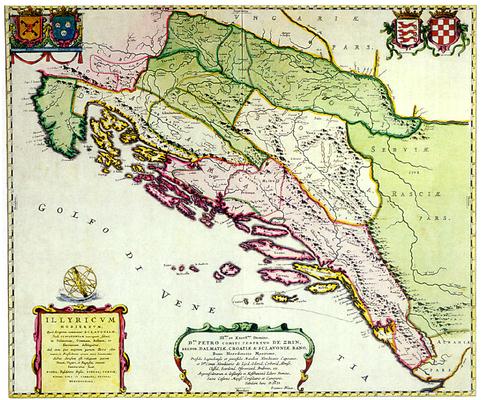
photo
from Croatian
Historical Musem
The map is dedicated to Petar Zrinski, ban of Croatia. It was created at the workshop of Joannes Blaeu in Amsterdam as an addition to the work by Ivan Lucic, "De Regno Dalmatiae et Croatiae libri sex", Amsterdam, 1666. Blaeu had inserted the map in Atlas Maior in 1667, and dedicated it to the Croatian ban Petar Zrinski (bottom of the map, in the middle):
To the most illustrious and noble lord, Prince Peter of Zrin, the ban of the Kingdom of Dalmatia, Croatia and Slavonia, hereditary ban of the Littoral, hereditary captain of the Legrad fortress and Medimurje peninsula, master and hereditary prince of Lika, Odorje, Krbava, Omis, Klis, Skradin, Ostrovica, Bribir etc.., Master of Kostajnica and the sliver mine at Gvozdansko, councillor and chamberlain to his anointed imperial majesty, master Ioannes Blaeu dedicates this map.
The above text is from Croatian Historical Musem.
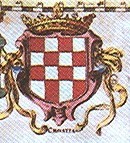
From
the map of Illyricum in the book by Ivan
Lucius Lucic:
De Regno Dalmatiae et Croatiae libri sex,
Amsterdam and Frankfurt, 1666
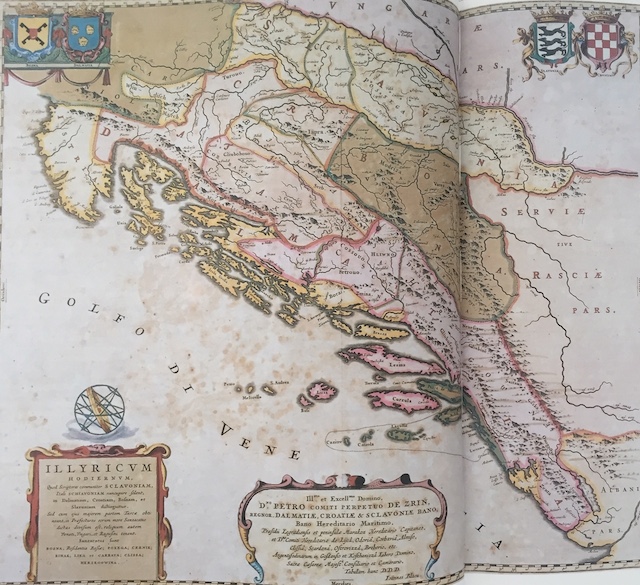
Ivan Lucic, the first Croatian historiographer: Map of Illyricum (i.e., of Slavonia, Croatia, Bosnia, Dalmatia),
from the atlas by Dutch cartographer Joan (or Johannes) Blaeu, 1669. Source of the photo [Markovic].
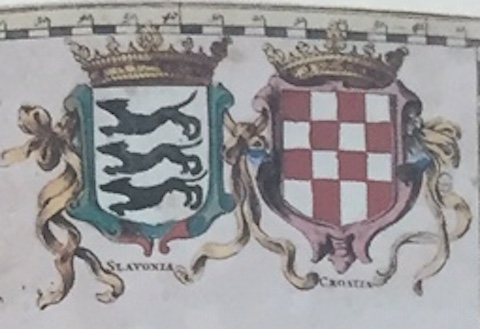
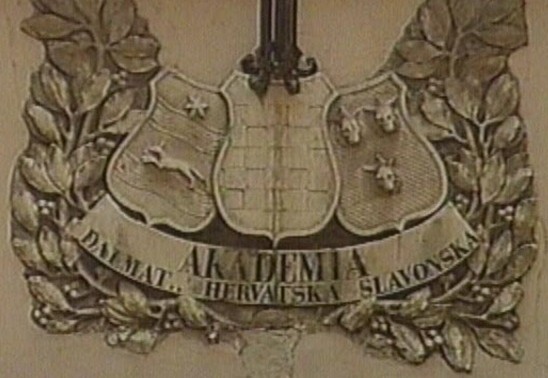
Akademia
Dalmatinska, Hervatska, Slavonska
in Zagreb, 1669.
Croatian Coat of Arms above the main entrance of the former
Jesuit gymnasium in Zagreb, founded in 1607 (today Gornjogradska
gimnazija in the Upper Town of Zagreb) .
Leopold I., the Emperor of the Holy Roman Empire, issued a Diploma in
1669, by which the status and privileges of a university
were accorded
to the Jesuit Academy in the Royal Free City of Zagreb. This represents
the beginning of the University
of Zagreb.

Shield that Lovro Leder, nobleman from the Turopolje District, obtained
in 1672.
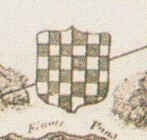
Croatian
Coat of Arms on the map of Croatia by Stjepan Glavac (Stephan M.
Glavach), 1673
source [Novak
et al, p. 108]
In 1673, a map of Croatia was published by the then Croatian
dignitaries, in which a unit of Milliaria
Croatica (i.e., Croatian mile
or hrvatska milja) appears,
defined as follows:



Lit.
- Zemljovid Hrvatske iz god. 1673., izradio ga
Stjepan Glavač D. I., Sarajevo 1937. (here, D.I. = Družba Isusova = Society of Jesus)
- Croatian Technical Lexicon.
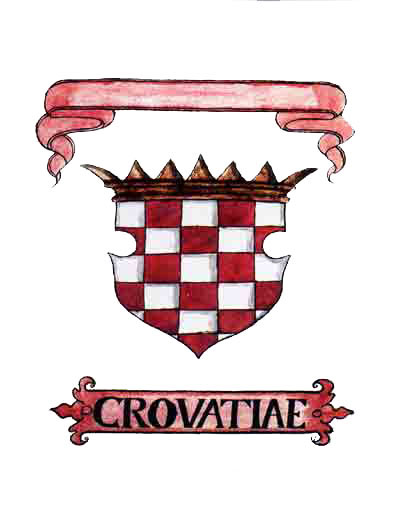
Fojnica
Heraldry from 1675 (kept in
Franciscan Monastery in Fojnica, Bosnia and Herzegovina)
the only collection of old coats of arms known in Bosnia
and Herzegovina
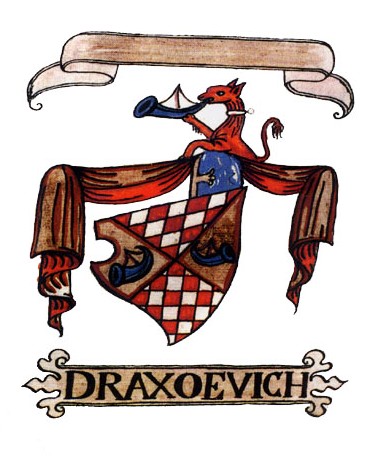
Coat
of Arms of Prince Zarko
Drazojevic
(1438-1508), from the Poljica Principality
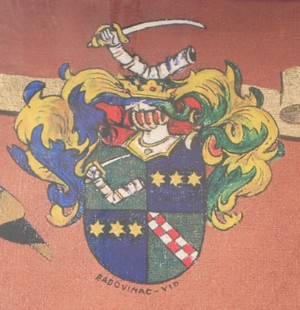
Coat
of Arms of Badovinac Vid,
Zumberak, exhibited in the Museum
of Zumberak in Stojdraga
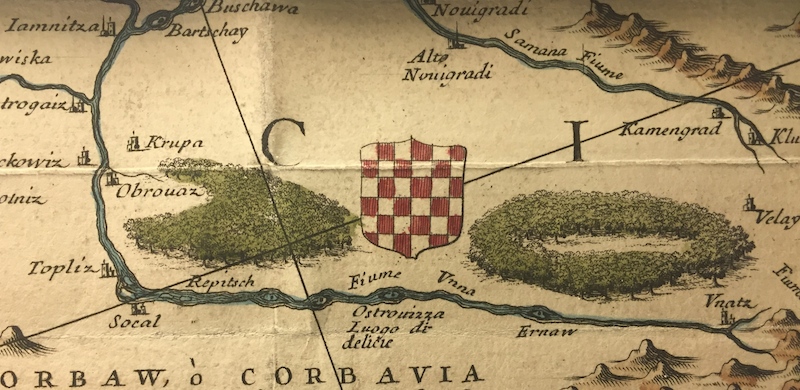
Vicenzo Maria Coronelli: The map of Istria and northern Dalmatia, arround 1688 (a detail)
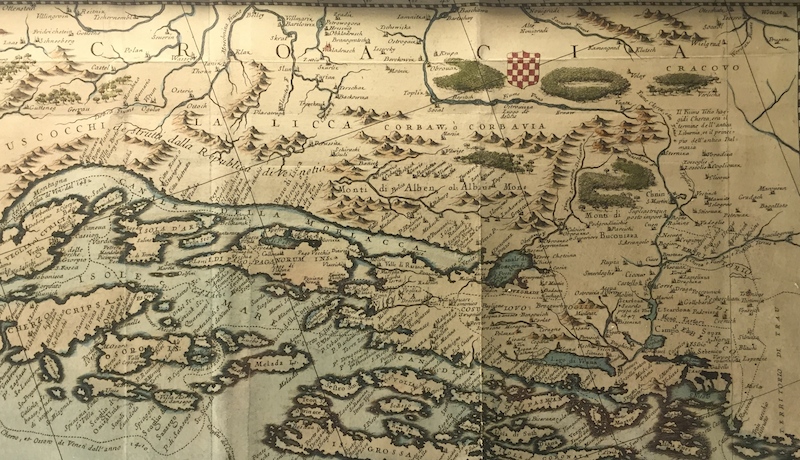
Vicenzo Maria Coronelli: The map of Istria and northern Dalmatia, arround 1688 (a part of the map)

Coats of arms of Croatia, Dalmatia and Slavonia of Nikola
III Erdödy, ban (governor)
of the United Kingdom (Trojedna Kraljevina) of Croatia, Dalmatia and
Slavonia 1680-1693.
The coats of arms are on his official ban's flag, and this is the
oldest known such ban's flag.
The flag is kept in the Zagreb Cathedral. Photos by Sanjin Strukić.

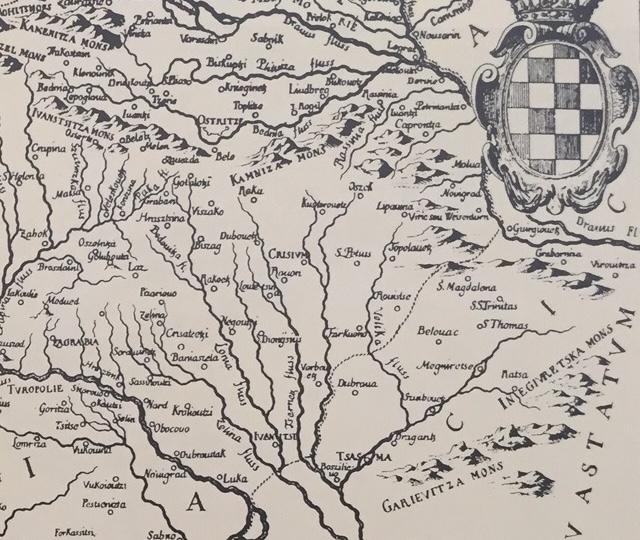
Detail
from a map of Croatia, with Croatian coat of arms,
from J.W. Valvazor: Die Ehre
des Herzogturms Crain, IV, 1689
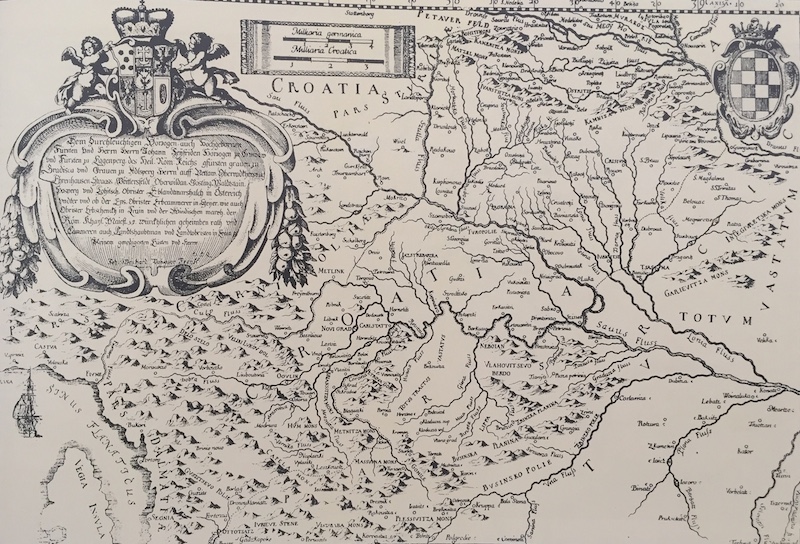
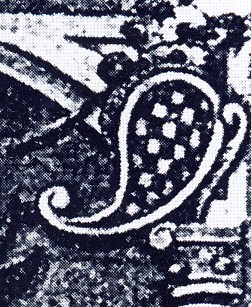
A
detail from Coat of Arms of Pavao
Ritter Vitezovic (1652- 1713),
Croatian historian and writer.
More extensive biography is available in
Croatian.

A
detail from Ivan Einhart's painting "Croatian dignitaries at King
Ladislav and the Queen", around 1690,
representing coat of arms of the
Kingdom of Croatia, Slavonia (on
the right) and Dalmatia
(on the left).
Kept in the Zagreb City Museum.


Vienna
(in Am Graben, not far from St.
Stephen's Cathedral),
Austria; Pestsäule (1693): Coat of Arms of Dalmatia, Croatia
and Bosnia (Rama).
By the courtesy of Mr. Kristian Dumancic, Vienna.
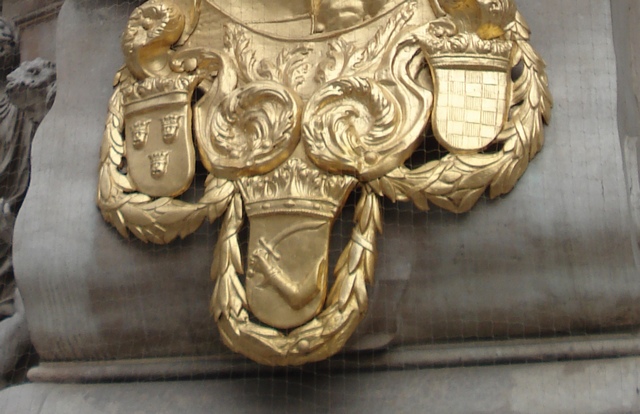

Mr. Mijo Jurić
by Croatian Coats of Arms in Am Graben
in Vienna, Austria
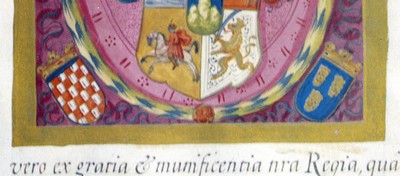
Coat
of Arms of the Brodaric family (a detail), Croatia, 1695, source [Molnar]
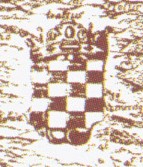
Croatian
Coat of Arms on a map by Vicenzo Maria Coronelli, printed in Venice,
1697
source [Novak
et al, p. 180]
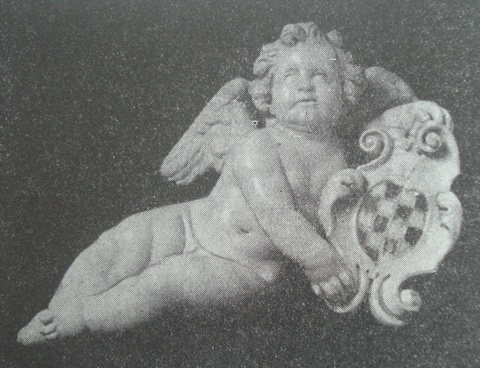
An angel with Croatian Coat of Arms, previously
on the altar of St. Luke in the Zagreb Cathedral (from 1703)
Photo from Croatian
Encyclopaedia, Zagreb
1941
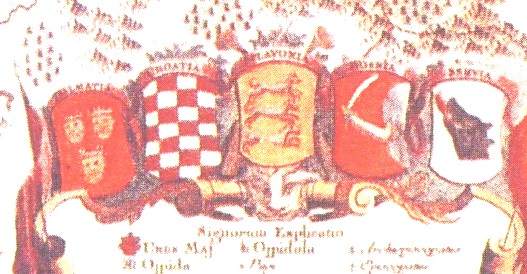
A
detail from Seutter's map, Augsburg 1709
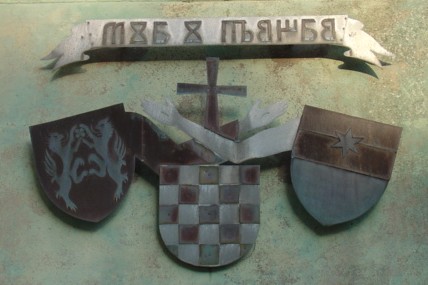
The
inscription "Peace and Good" (Mir i dobro) in the Croatian
Glagolitic Script,
at the main entrance of the Franciscan convent on the islet of Kosljun
near the town of Punat
on the island of Krk

Ivan
V Drašković, ~1660-1733 (Trakošćan Castle)
Ban (governor) of the United Kingdom of Croatia, Slavonia and Dalmatia
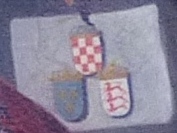

Croatian
Coat of Arms (Croatien) in Sevnica, Slovenia, 17th century;
there are also nice wooden Coats of Arms of Slavonia
(Schlavon.) Dalmatia
(Dalmaci.),
and of the city of Zagreb
(Agram)
The
Coats of Arms were first placed in the lower palace in Sevnica,
and then moved to the upper palace, to its Conference hall
(many thanks to Blandina and Ante Markovic for information and photos)
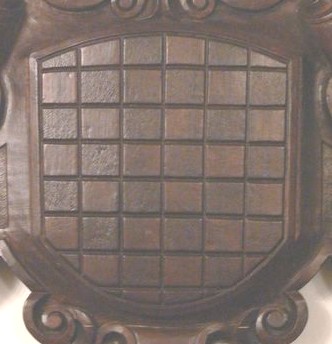
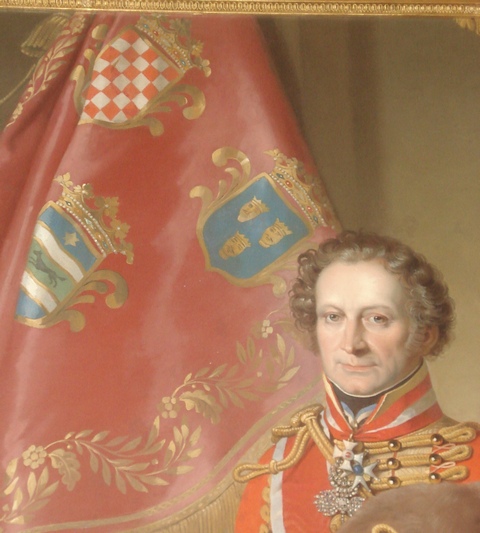
Ivan Pálffy, Croatian ban (Governor) 1704-1732, ban of
United
Kingdom of Croatia, Slavonia and Dalmatia.
Portrait kept in the Croatian History Museum, Zagreb (detail).
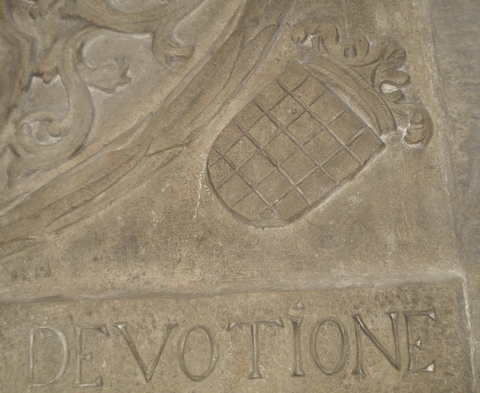
Croatian
Coat of Arms from
1732 in the church of St Kapistran
in Ilok, Croatian town on the Danube river
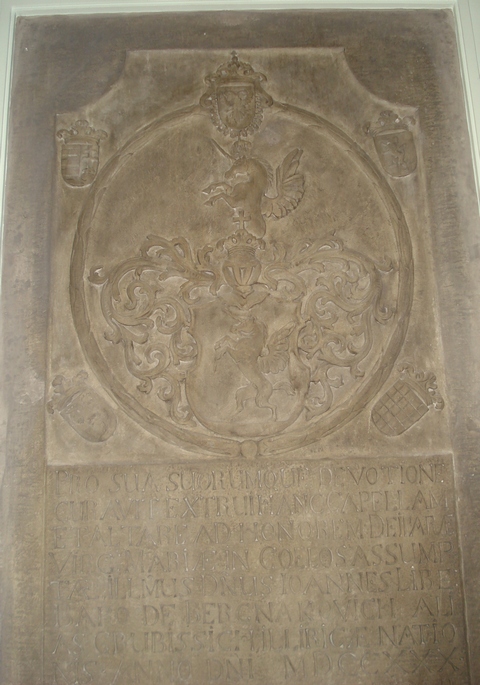

Tablet
in the church of St. Ivan Kapistran in
Ilok:
...BEBGNA KOVICH ALIAS GRUBISSICH ILIRICAE NATIONIS (i.e. of Croatian Nation), ... 1732.
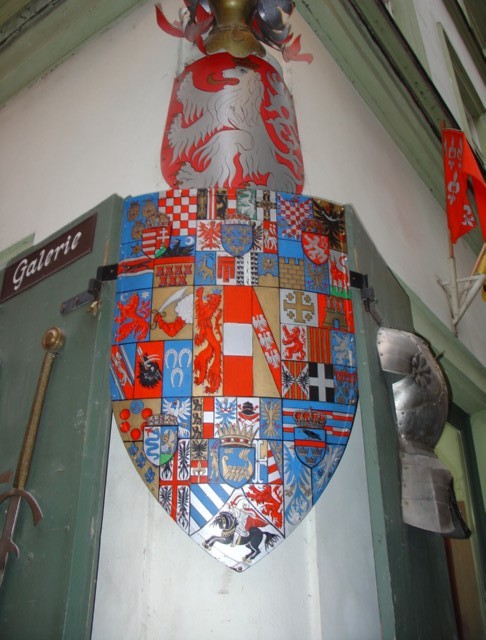
A
shield in Prague, capital of Czechia, with Croatian coat of arms
(I do not know the year)

![]()
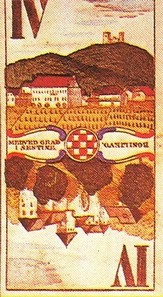
Bosiljevo
and Medvedgrad


Coat of arms of the Plemenita turopoljska općina - Noble district of Turopolje from 1737,
where Bartol Jurjevic (or Gyurgievits) was born.
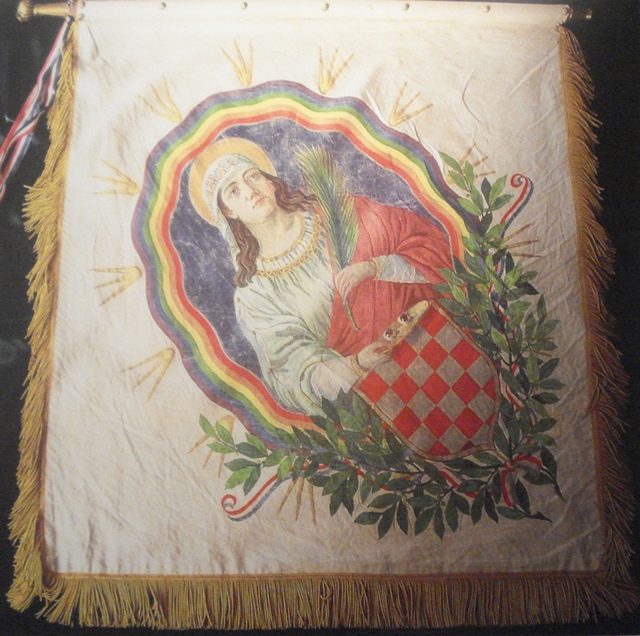
Coat of arms of the Plemenita turopoljska općina - Noble district of Turopolje from 1737
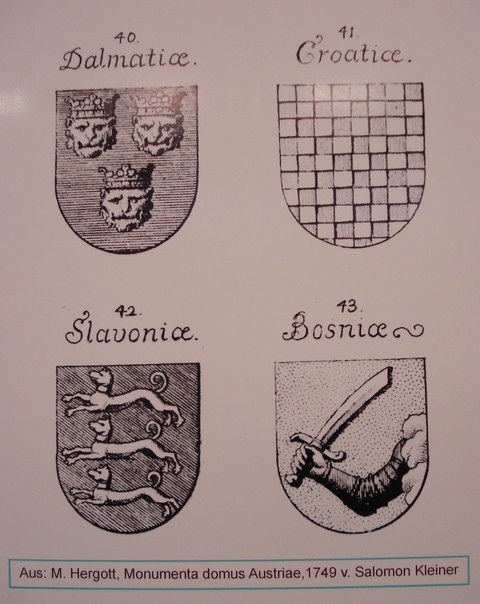
Croatian
Coats of Arm from 1749.
By the courtesy of Josip Sersic and Mijo Juric, Vienna 2009.
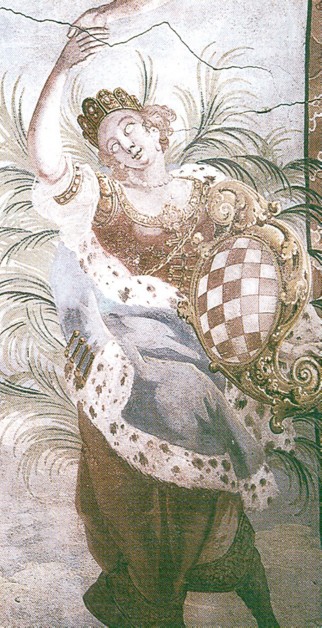
The
Baroque church of St. Martin Bishop, Donja Voća (north of Zagreb),
mural by Ivan
Ranger, 18th century
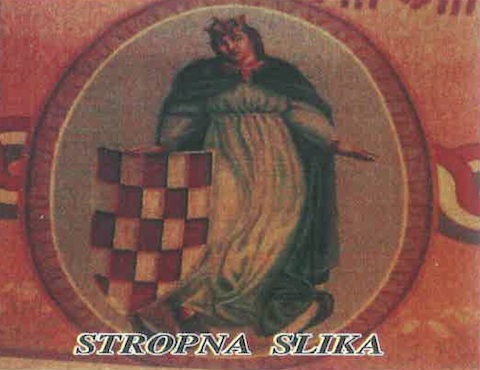
Ceiling drawing of Fidelissima Advocata Croatorum, probably from the 17th
century,
kept in the church of the Ascension of Blessed Virgin Mary, built in
1240 in Donja Rijeka (near the town of Križevci).
Many thanks to Marina Car, Zagreb, for her kind information. See her
own drawing inspired by this work:

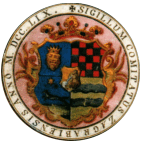
Official
seal of the Zagreb zupanija (county),
with Croatian coat of arms, 1759,
Croatian coat of arms and the seal were granted by Queen Maria Theresia
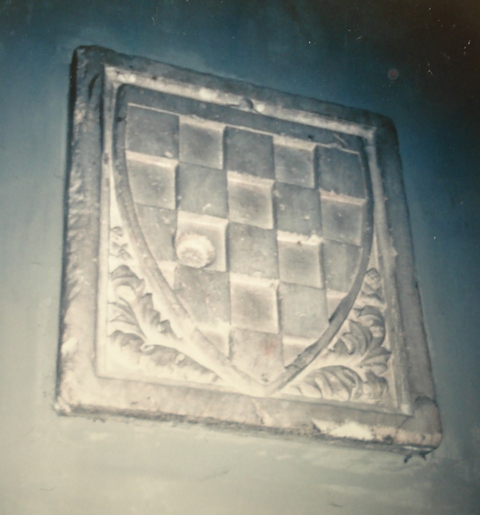
Croatian Coat of Arms in the Cathedral of St.
Lovrijenac, Lugano, Switzerland (date unknown), on a right
pillar.
The Croatian Coat of Arms is engraved also on bishop's chain in Lugano
(we do not possess its photo).
Information and photo by the courtesy of Mr. Seno Markulin, Sidney,
Australia.

Two
details from Regnum Croatiae, map of Croatian Kingdom by Johann van der
Bruggen, Venice 1737
source [Novak
et al, p. 54]

Regnum Croatiae, map of Croatian Kingdom (Johann van der
Bruggen, Venice 1737).
Source Old Adriatic Sea - Croatia maps
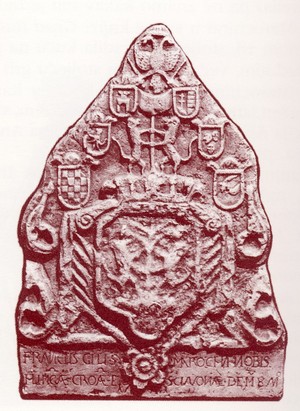
A
monument from the town of Bakar on Croatian coast, from 1741;
photo from [Ostric]

A
detail from the Bakar monument.
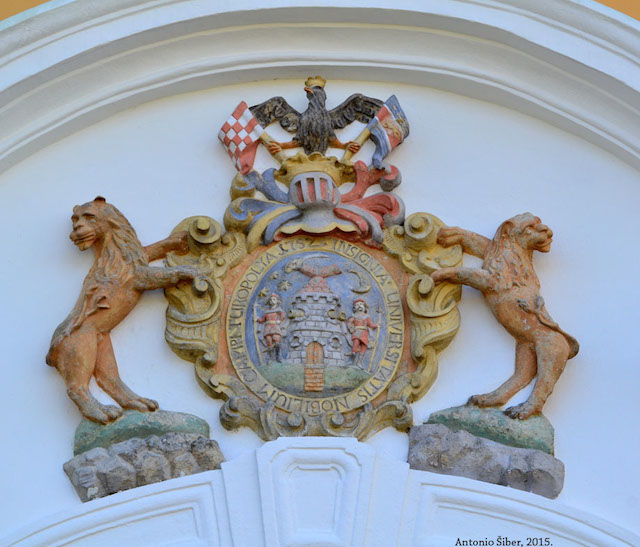
Lukavec bourg in Turopolje near Velika Gorica, south of the city of Zagreb. Photos by Antonio Šiber.
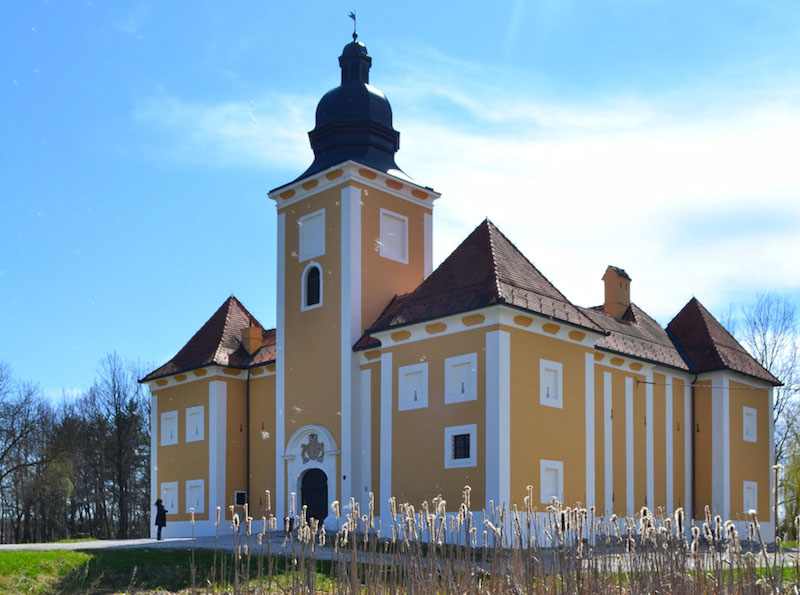
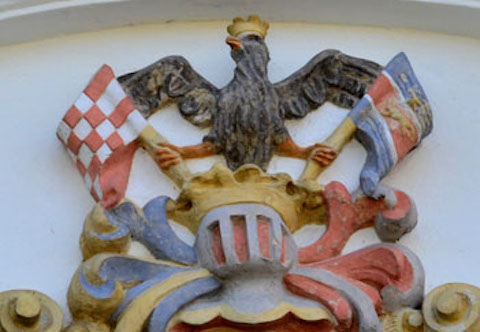
Coats of Arms of Croatia and Slavonia.
Coats of Arms of Dalmatia, Croatia, and Slavonia, 1650, shown on
a copper plate engraving by Jahann Daniel Herz from 1750, kept in the Hungarian National Museum.
Exhibited at the Klovićevi dvori Museum in Zagreb in the Automn 2020.
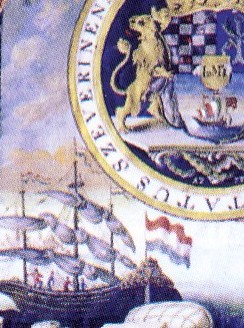
A
detail from the Coat of arms of the Severin County, 1778,
assigned by the Queen Maria Theresia; note Croatian tricolors on the
sailing ship
source:
Jozo Ivanovic, Croatian
State Archives, 2006, ISBN
953-6005-78-6
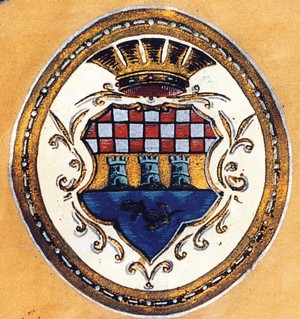
Coat
of Arms of the town of Bakar from 1779 drawn by Matija Mazic (1896);
photo from [Ostric]

Dubica, Coat of Arms of the noble family of Mikašinović.
Source Katica Delić: Hrvatska Dubica
u slici i riječi, Dubica 2013.
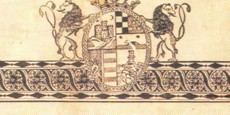
A
detail from a Certificate of a Master Craftsman, 18th century
(kept in the Croatian State Archives
in Zagreb)

Croatia's capital Zagreb in 1780

1780
Copper plate from 1780 by Johann Philip Binder, kept in the Hungarian National Museum in Budapest.
Exhibited in the Automn 2020 at Klovićevi dovri in Zagreb.
Coats of Arms of Dalmatia, Slavonia, Croatia, and Bosnia

Countess
Katarina Patacic (1750-1811), from the title page of her book Pesme
Horvatzke (Croatian Poems),
Varazdin 1781
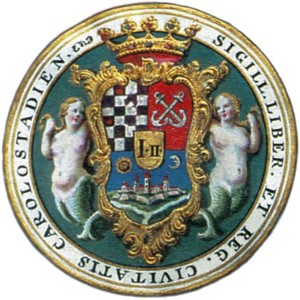
Grb
of the town of Karlovac, 1781

Croatian Coat of Arms in the church of Holy Trinity (crkva Presvetog Trojstva) in Visoko (near the towns of
Zelina, Križevci and Marof, turning to the right at Bisag grad), not far from the city of Zagreb.

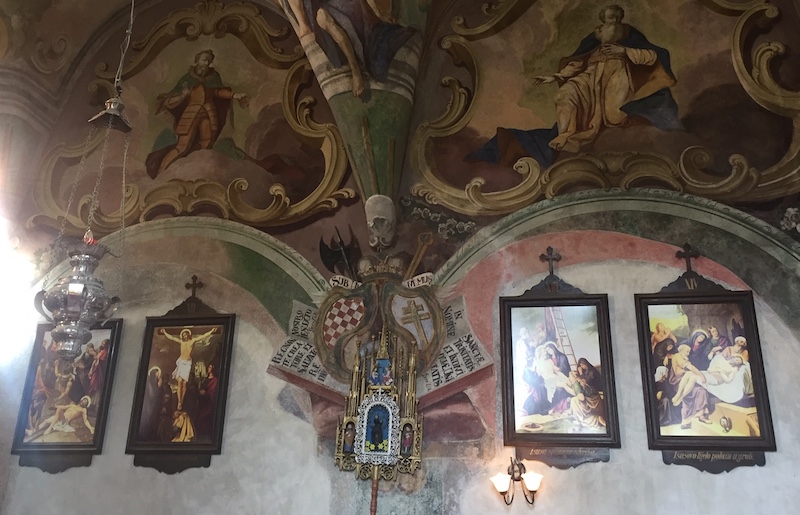
Many thanks to Dr. Hrvojka Mihanović-Salopek, for revealing us the Baroque church of Holy Trinity in Visoko near Zagreb.


The Story of Prag Museum, Czech Republic

Coats of Arms of Croatia and Dalmatia
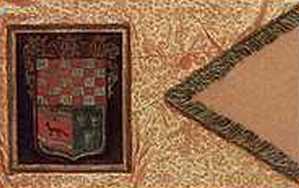
Konjička zastava (equestrian flag), United
Kingdom of Croatia, Slavonia and Dalmatia, 1797, source
- until 1600
- 1600-1800
- 1800-1900
- 1900 until today
- References
Croatia - its History, Culture and Science
